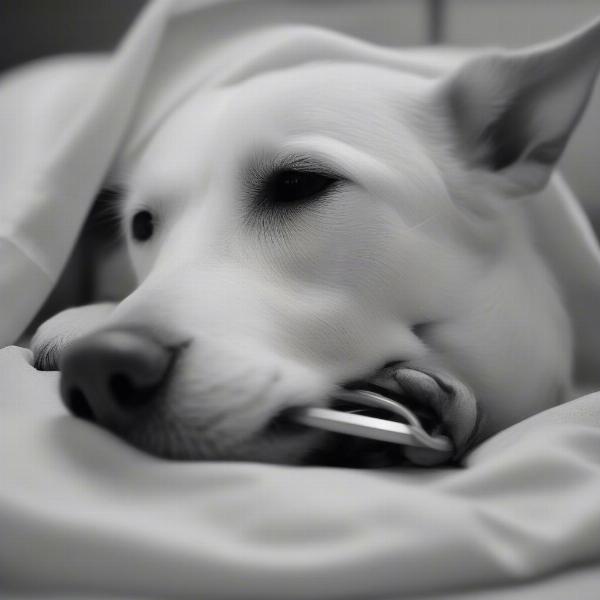Salivary gland tumors in dogs are an unfortunately common occurrence. These tumors can develop in any of the salivary glands, including those located under the tongue, in the cheek area, or near the ears. This guide provides a comprehensive overview of salivary gland tumors in dogs, including their causes, symptoms, diagnosis, and treatment options. Understanding these tumors is crucial for early detection and intervention, ensuring the best possible outcome for your canine companion.
Understanding Salivary Gland Tumors
Salivary gland tumors can be benign or malignant. Benign tumors are typically slow-growing and don’t spread to other parts of the body. Malignant tumors, however, can be aggressive, spreading rapidly to surrounding tissues and distant organs. While the exact cause of these tumors is unknown, genetics and environmental factors may play a role.
Recognizing the Signs and Symptoms
Early detection of salivary gland tumors is crucial. Common symptoms include swelling or a lump under the jaw, in the cheek area, or near the ears. You might also notice difficulty eating or swallowing, excessive drooling, or bleeding from the mouth. If you observe any of these symptoms, consult your veterinarian immediately.
Diagnosing Salivary Gland Tumors in Dogs
Diagnosing salivary gland tumors involves a thorough physical examination and diagnostic tests. Your veterinarian will likely perform a fine-needle aspiration, where a small needle is inserted into the tumor to collect cells for analysis. Other diagnostic tools may include X-rays, CT scans, or MRIs to determine the size and extent of the tumor and check for metastasis.
Treatment Options for Salivary Gland Tumors
Treatment options for salivary gland tumors vary depending on the type and stage of the tumor. Surgical removal is often the preferred treatment, particularly for benign tumors. For malignant tumors, surgery may be combined with radiation therapy or chemotherapy to eliminate cancerous cells and prevent recurrence. salivary gland tumors in dogs goes into more detail on these treatment methods.
Post-Operative Care and Prognosis
Following surgery, your dog will require careful monitoring and pain management. Your veterinarian will provide specific instructions regarding wound care, diet, and activity levels. The prognosis for dogs with salivary gland tumors depends on various factors, including the type and stage of the tumor, the success of the surgery, and the overall health of the dog. Regular check-ups are essential to monitor for recurrence and manage any complications. can a dog die from salivary mucocele provides more information on potential complications.
 Dog after salivary gland tumor removal surgery
Dog after salivary gland tumor removal surgery
Conclusion
Salivary gland tumors in dogs can be a concerning diagnosis, but early detection and appropriate treatment can significantly improve outcomes. By being aware of the signs and symptoms, seeking prompt veterinary care, and following your veterinarian’s recommendations, you can help ensure your furry friend receives the best possible care. Remember, being proactive is key in managing salivary gland tumors in dogs. Don’t hesitate to ask your vet any questions you may have about this condition. dog face swelling one side may also offer further insight.
FAQ
- What are the most common types of salivary gland tumors in dogs? The most common types are adenocarcinomas, followed by adenomas and mixed tumors.
- Is a swollen face always a sign of a salivary gland tumor? No, facial swelling can have various causes, including infections, abscesses, or allergic reactions. facial nerve paralysis dog explains some other potential causes.
- How can I prevent salivary gland tumors in my dog? Unfortunately, there’s no known way to prevent these tumors entirely. However, regular veterinary check-ups and prompt attention to any unusual lumps or swellings can help with early detection.
- Are certain breeds predisposed to salivary gland tumors? While any breed can develop these tumors, some breeds, like Cocker Spaniels and Poodles, may be slightly more susceptible.
- What is the typical recovery time after surgery for a salivary gland tumor? Recovery time varies depending on the extent of the surgery and the individual dog, but generally takes several weeks.
- Can salivary gland tumors recur after surgery? Yes, particularly malignant tumors have the potential to recur even after successful removal.
- What are the long-term effects of salivary gland tumor removal? Depending on the location and extent of the surgery, some dogs may experience temporary or permanent facial nerve damage.
ILM Dog: Your Trusted Partner in Canine Care
ILM Dog is a leading international online resource dedicated to providing expert advice and practical information on all aspects of dog care and wellbeing. We offer a wealth of knowledge on dog breeds, health, training, nutrition, grooming, and much more, catering to both new and experienced dog owners worldwide. We strive to empower dog owners with the information they need to make informed decisions about their furry companions. For expert advice tailored to your dog’s specific needs, contact us at [email protected] or call +44 20-3965-8624. ILM Dog is here to support you every step of the way.